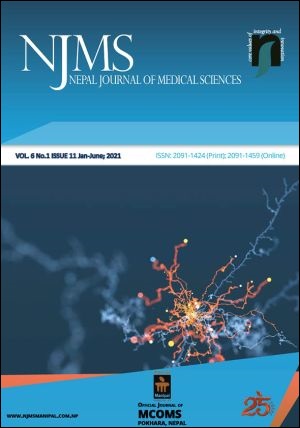Retrospective Evaluation of Patients Leaving Against Medical Advice from Intensive Care Unit (ICU) in Tertiary Care Teaching Hospital
DOI:
https://doi.org/10.3126/njms.v6i1.36724Keywords:
Intensive Care Unit (ICU), Leaving Against Medical Advice (LAMA), Prevalence RateAbstract
Introduction: Leaving Against Medical Advice (LAMA) can cause a state of dilemma among the treating physician whether to continue the treatment or to de-escalate from the treatment. It can deteriorate the primary disease of the patient, leading to an increase rate of re-admission to the hospital, increased morbidity and mortality. This is a worldwide phenomenon and the prevalence of LAMA varies between various countries and between different region, religion, and the socioeconomic status of the patient in the same country.
Methods: The hospital records from 1st December 2018 to 30th November 2019 of a tertiary care teaching hospital were studied. Patient demography, disease characteristics and length of ICU stay and the factors leading to LAMA were noted and statistically analysed.
Results: During the study period, 14.5% of patients asked for LAMA. The mean age was 51.22 ± 22.39 years (range 8 months to 97 years) with Male predominance (n= 288, 62.60%) over Female (n= 172, 37.39%). Patients residing in rural areas were 56.08% (n=258) and 63.91% were financially dependent on others for their living. The mean length of stay in hospital was 3.02 ± 3.50 days while 30.86% of patients required mechanical ventilation. About 51.73% of patients taking LAMA were admitted from the Internal medicine department. Around 79.56% were Hindus, with 54.34% opting for LAMA due to financial restrain followed by poor prognosis (22.60 %).
Conclusion: The large number of patients admitted in ICU opts out for LAMA. This necessitates formulation and implementation of strategies to reduce the prevalence of LAMA discharge so that patient gets the optimum level of care and the burden in the health care system is reduced
Downloads
Downloads
Published
How to Cite
Issue
Section
License
Copyright © by Nepal Journal of Medical Sciences. The ideas and opinions expressed by authors of articles summarized, quoted, or published in full text in this Journal represents only opinions of authors and do not necessarily reflect the official policy of Nepal Journal of Medical Sciences or the institute with which the author(s) is (are) affiliated, unless so specified.




